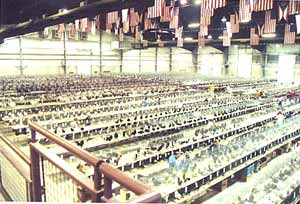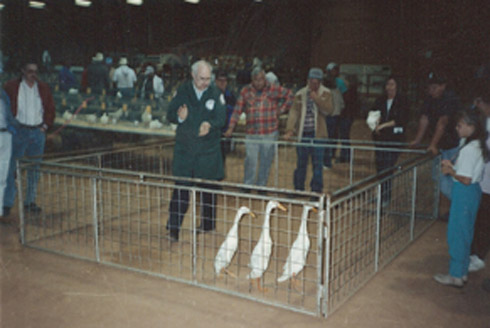 |

|
Currently there are no events or updates to display. |

Frequently Asked Questions About Poultry Shows Why do people want to show their birds? People show their birds to satisfy the desire for competition, to see how good their birds are in comparison to others, and because it is just plain fun.
What kinds of shows are there? They range from the small county fairs to major poultry shows at which thousands of birds are exhibited. Pictured above is the 1998 Ohio National Show at which over twelve thousand six hundred birds were exhibited. In most parts of this country, even in some urban areas, poultry shows are often incorporated into county, state and regional fairs which take place starting in mid-summer and go on well into the fall. One can call the local extension office to find out about the fairs in one's local area. You have to send for a catalog or view it online and then fill out an entry as well as pay entry fees. Be careful to observe the deadlines and to send in a properly filled out entry. In many states including Illinois, blood testing is required. If that is the case in your area, do not wait until the last minute to get it done . A list of licensed testers should be available from the state. The county or even state fair may not have a breed specific class for all breeds; they may group some breeds together. If you are not sure about which category your birds fall in to, ask for help from an extension agent or from a 4H leader who is familiar with poultry. Also, be sure that you get the age classification right. If the bird was hatched that same calendar year, it is considered to be young. If the bird was hatched the previous year or earlier, it is an old bird. By the way, what I have just told you about deadlines, entry fees and getting the birds into the right classifications also applies to all other poultry shows. Your best bet is to locate a local poultry breeder with some experience at showing and have him/her go over the process with you the first time or two. County fairs are great places to get your feet wet in the showing business and to get a gauge on what quality your birds are. Be aware, however, that many small county fairs do not hire licensed poultry judges, so their placements are sometimes questionable. All over the country, there are also poultry shows which are independent of any fair and which are run by poultry fanciers on a volunteer basis. Such shows may be held during the spring and early summer but the largest and most important ones are usually held in the fall and early winter months (they begin a little later in the Far West). These shows may be small ones, which will host an entry of only a few hundred birds, or they may be huge shows hosting thousands of birds. Goose row at a major show How do I Find Out About These Shows? The most reliable way to keep up with upcoming shows and with just about everything else connected with exhibition poultry is to subscribe to the Poultry Press The address, current subscription rate and all other particulars can be found in my page on resources. If you intend to become serious about exhibition poultry, a subscription to the POULTRY PRESS is a must. What Else Do I Need To Know about the Shows? Do not be afraid to call the Show Secretary and ask if you have any questions when you fill out your entry form. All catalogs have a phone number you can call- use it. Also, be aware that in many states, you are required to show proof that your birds are free from certain highly contagious diseases. This is done through blood testing which should be done on a yearly basis. There is a program called the NPIP (National Poultry Improvement Plan) which provides yearly testing at no cost or at nominal cost to the fancier and which then provides a form which is the proof required by most shows. I highly recommend that you join the plan. You can contact your local Extension office to arrange for the testing. Once your birds have been tested and you have been provided with the completed form, keep the original on file and make copies to send with your entry to the shows. DO NOT send them the original. Do not wait until the last minute to take care of blood testing if it is required either in your home state or in a state where you are attending a show. Do not assume that the testing requirements are the same in all states because they are not. Always include your phone number when you send in an entry whether the entry form requires it or not. Always keep a copy of the entry form for yourself. If the Secretary has a question about your entry, you want him to be able to get in contact with you. He may call collect (remember, these people are volunteers and usually have no money supplied to them for such things). Be aware that some shows are two days in length and some are only one-day shows.
Runners are best judged in a ring where they can have their carriage fairly evaluated. Exhibitors are often asked to help move birds between the cages and the ring. Never show a Runner without a numbered band. Judge Lou Horton selects Best White Runner at a major show. How Do I Prepare My Birds for the Show? Basically, one needs to have one's birds in good feather and clean when one exhibits. Clean also means that the birds should be free of lice and mites. There are powders and sprays for the lice and mites. Birds should be kept free of them all the time, of course. Mites are parasites, which feed off of the blood of their host; lice eat feathers and can ruin the plumage of chickens or waterfowl. It takes 6-8 weeks to replace a large feather; go over your birds at least 8 weeks before a show and pull out and broken or damaged feathers to give them time to be replaced. Waterfowl do not need to be washed for a show if they are kept in clean conditions and supplied with clean bathing water. Chickens do need occasional washing. The subject of proper washing of chickens is too complicated to go into deeply here. See the related article on fitting chickens for a show. The key things are to get all the soap washed out of the plumage and to rinse the bird thoroughly in warm, not hot water. Never wash birds the night before the show; it should be done two or three days before the show and then the bird should be housed in a clean, draft free pen after it has thoroughly dried. Plan in advance how you will transport the birds to the show. Experienced exhibitors have "carry coops" but you may have to use cardboard boxes or another type of container. Sturdy cardboard boxes of the type beer is carried in works very well. Another very good container is the plastic pet carrier available in many places. They are fairly inexpensive if you buy them on sale and they are light, easy to clean, and smooth on the inside. They also come in a variety of sizes. Do not use wire cages or you will risk fraying the bird's feathers. Also, do not overcrowd the birds or you may undo all of your careful preparations. Get to the show in plenty of time so that you can coop in your birds and allow them to adjust to their new surroundings before the judging starts. Some shows allow exhibitors to clerk for a judge. Clerking can be a wonderful learning experience. One should not ask to clerk, however, if one has birds in the class to be judged. Before I close, a few words about poultry show etiquette would be appropriate. Stay out of the aisle when the judge is working in it. Do not speak to the judge when he is working unless he says something to you. Wait until after a judge has finished his judging assignment before asking him about placements. There is nothing wrong with asking a judge why he placed the birds in a certain way; just do it respectfully. Last but not least, obey the show rules. Observe the cooping out time and enjoy the experience! There is today a new wrinkle in the show world: the double sanctioned show. Basically, a double sanctioned show is one where two sets of judges independently evaluate the birds in two show in one. for those wanting to earn ABA or APA points which qualify them for indidual honors such as "Master Exhibitor". Even if you do not care about the points, the second evaluation gives you a chance to get another judge's opinion and point of view. try one, you might like it. Originally published: 10-06-2002Last updated: 04-09-2015 |
Copyright © 1997 - 2025 Acorn Hollow Bantams. All Rights Reserved. | Terms of Use | Privacy Policy




